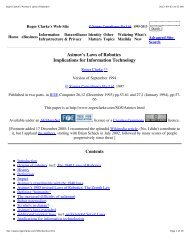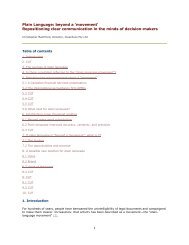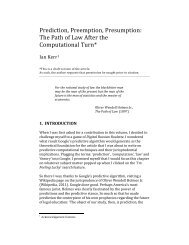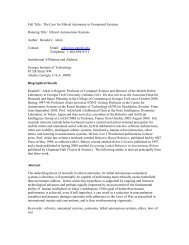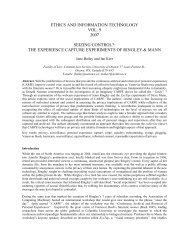Materializing Morality: Design Ethics and Technological Mediation.
Materializing Morality: Design Ethics and Technological Mediation.
Materializing Morality: Design Ethics and Technological Mediation.
You also want an ePaper? Increase the reach of your titles
YUMPU automatically turns print PDFs into web optimized ePapers that Google loves.
Verbeek / <strong>Materializing</strong> <strong>Morality</strong> 371<br />
would be that it is important to find a democratic way to moralize technology.<br />
In the following, I will elaborate a way to do this.<br />
<strong>Design</strong>ing <strong>Mediation</strong>s<br />
The moral impediments to the moralization of technology can be<br />
countered much more easily than the practical impediments. The moralization<br />
of technological artifacts is not as easy as it might seem to be. To build<br />
in specific forms of mediation in technologies, designers need to anticipate<br />
the future mediating role of the technologies they are designing. And this is<br />
a complex task since there is no direct relationship between the activities of<br />
designers <strong>and</strong> the mediating role of the technologies they are designing. As<br />
became clear above, the mediating role of technologies comes about in a<br />
complex interplay between technologies <strong>and</strong> their users.<br />
Technologies are multistable, as Ihde calls it. They have no fixed identity<br />
but get defined only in their context of use. Technologies have to be<br />
interpreted <strong>and</strong> appropriated by their users to be more than just objects<br />
lying around. Only when human beings use them, artifacts become artifacts<br />
for doing something. And this “for doing something” is determined not<br />
entirely by the properties of the artifact itself but also by the ways users deal<br />
with them, as became clear in the example of the telephone that was originally<br />
designed as a hearing aid. If this were not the case, accepting the idea<br />
of technological mediation would take us back to technological determinism;<br />
technologies would then be able to determine the behavior of their<br />
users all by themselves instead of being part of a sociotechnical network.<br />
This multistability of technologies makes it very difficult to predict the<br />
ways in which technologies will influence human actions <strong>and</strong> accordingly<br />
to evaluate this influence in ethical terms. Technologies can be used in<br />
unforeseen ways <strong>and</strong> therefore have an unforeseen influence on human<br />
actions. Besides this, unforeseen forms of mediation can also emerge when<br />
technologies are indeed used as the designer intended. Revolving doors, for<br />
example, were designed to make it possible to enter a building while keeping<br />
the draught outside. Once they were used, they also appeared to inhibit<br />
people in a wheelchair to enter a building.<br />
<strong>Design</strong>ers thus help to shape the mediating roles of technologies, but<br />
these roles also depend on the ways in which the technologies are used <strong>and</strong><br />
on the ways in which the technologies in question allow unforeseen mediations<br />
to emerge. The suggestion that scripts are a result of inscriptions<br />
(Akrich) or delegations (Latour) therefore does not do enough justice to the<br />
Downloaded from sth.sagepub.com at QUEENS UNIV LIBRARIES on November 30, 2011



